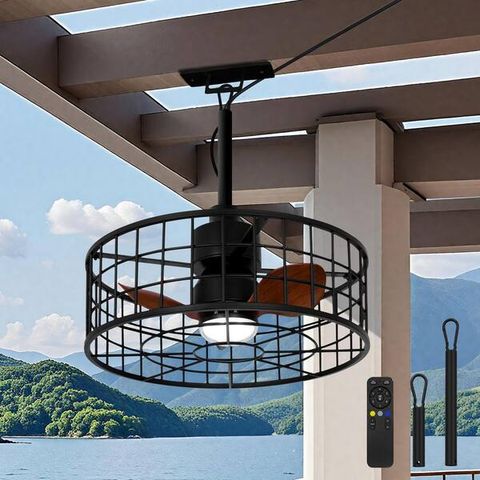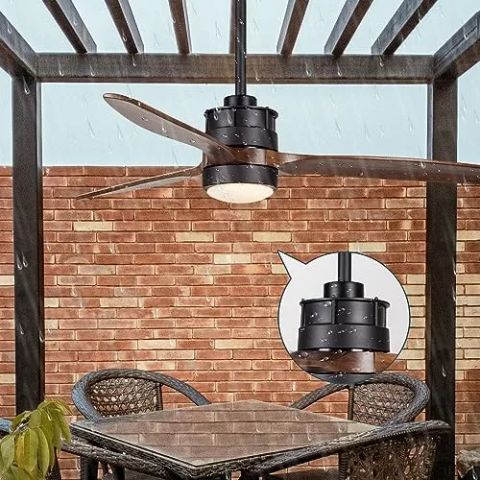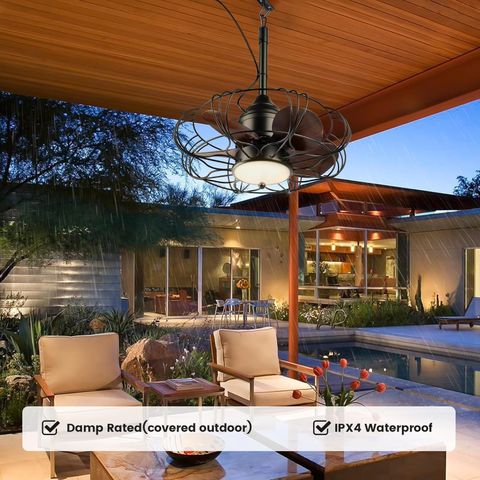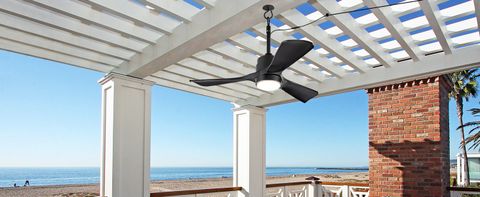Picture this: you’re relaxing on your patio, sipping lemonade, and feeling the gentle breeze from a ceiling fan spinning overhead. That dreamy scenario becomes reality when you choose the right weatherproof outdoor ceiling fan. But with so many options out there, how do you know which one will truly stand up to the elements? Let’s break down what makes a fan worthy of the great outdoors.
Outdoor living spaces have become increasingly popular, transforming backyards into cozy retreats and patios into entertaining havens. But there’s one thing that can quickly turn a pleasant evening into an uncomfortable ordeal – heat and humidity. Enter outdoor ceiling fans, the unsung heroes that can make or break your outdoor comfort experience. These aren’t your typical indoor fans, and choosing the wrong one can lead to disappointment, expensive replacements, and plenty of frustration. The secret lies in understanding what features make a fan truly weatherproof rather than just water-resistant.
Understanding Weatherproof Ratings and IP Codes
When shopping for outdoor fans, you’ll encounter terms like IP ratings and weatherproof certifications. Think of these as the fan’s passport to surviving the elements. The International Protection (IP) rating system is your best friend here. An IP65 rating means the fan is dust-tight and protected against water jets from any direction. That’s pretty solid protection, right? But wait, there’s more. IP67 goes even further, offering protection against temporary immersion in water. The numbers matter – the first digit indicates dust protection, while the second shows water resistance. Not all fans with ‘weatherproof’ labels are created equal. Some might be rated for light rain, others for heavy storms. It’s crucial to understand exactly what these ratings mean before making your choice. A fan rated IP65 can handle a light shower, but it’s not designed for a hurricane. Check if the manufacturer provides specific details about their testing methods and conditions.
Motor Quality and Durability Considerations
The heart of any good fan is its motor, and outdoor fans need motors built for endurance. Look for motors specifically designed for outdoor use, often labeled as ‘outdoor-rated’ or ‘marine-grade.’ These motors typically feature corrosion-resistant materials and sealed bearings that prevent moisture from causing damage. A high-quality motor can last decades, while a cheap alternative might fail after just a few seasons. What does this mean for you? Well, imagine spending hundreds of dollars on a beautiful fan only to have it stop working after one summer because of a faulty motor. That’s why investing in a quality motor pays off in the long run. Some manufacturers offer extended warranties on motors, which speaks volumes about their confidence in the product. Don’t get caught in the trap of buying the cheapest option – think about the cost per year of ownership rather than just the upfront price tag.
Blade Material and Design Matters
Outdoor blades face constant exposure to sun, rain, wind, and temperature changes. That’s why blade material matters more than you might think. Aluminum blades are popular choices because they resist rust and corrosion better than wood or plastic. They’re also lightweight enough to spin efficiently while being sturdy enough to handle strong winds. Plastic blades, on the other hand, are often less expensive but may warp over time with UV exposure. Wood blades can look gorgeous but require regular maintenance and protection. The shape of the blades also affects performance. Curved blades generally provide better airflow than straight-blade designs. Some fans come with reversible blades, allowing you to adjust the angle for optimal air movement. Consider the size too – larger blades move more air, but they also create more wind resistance. A 5-foot blade is great for larger spaces, while 4-foot blades work well for smaller areas like covered patios.
Weatherproof Housing and Construction
The housing protects everything inside the fan from the elements. Look for fans with durable materials like powder-coated aluminum or stainless steel. These materials resist rust, fading, and general wear much better than cheaper alternatives. The housing should be sealed properly to prevent water from entering critical components. Some fans feature additional protective features like rubber gaskets around the mounting hardware. The mounting system itself is crucial – it needs to securely attach to your ceiling structure and withstand wind loads. Many outdoor fans come with special mounting brackets designed specifically for outdoor use. Check if the housing has proper ventilation to prevent overheating during operation. Poor ventilation can cause the motor to overheat and fail prematurely. Also consider the weight capacity – ensure the mounting structure can support both the fan and its maximum operating load.
Control Options and Smart Features
Modern outdoor fans offer various control options beyond simple on/off switches. Remote controls are convenient, especially when you’re relaxing in a chair far from a wall switch. Some fans come with wall controls, while others feature smartphone apps that let you control them from anywhere. Smart features can include timer functions, speed adjustments, and even integration with home automation systems. But remember, with more features comes more complexity. Make sure the control system is user-friendly and reliable. Battery-powered remotes are handy but require regular replacement. Bluetooth and Wi-Fi connectivity can be great, but they also add potential points of failure. Some fans include built-in LED lighting, which can be useful for evening entertainment. However, LED lights also generate heat, so ensure they’re properly ventilated. Consider how often you’ll actually use the smart features versus the basic functionality.
Installation Requirements and Professional Help
While some outdoor fans are designed for DIY installation, others require professional expertise. Before purchasing, check if the fan requires electrical wiring or if it’s hardwired into your home’s electrical system. Some models are plug-in, while others need a licensed electrician. The mounting location matters significantly – it needs to be secure and appropriate for the environment. If you’re installing on a covered porch, the requirements differ from an uncovered deck. Wind load calculations are essential for proper installation, especially in areas prone to high winds. The mounting bracket should be rated for the fan’s weight and wind forces. Many manufacturers provide detailed installation instructions, but don’t hesitate to call for professional advice if you’re unsure. Professional installation can save you from costly mistakes and ensure safety. Consider the local building codes and whether permits are required for outdoor electrical installations. Sometimes the most economical choice is hiring someone experienced rather than trying to save money on installation.
Choosing the right weatherproof outdoor ceiling fan isn’t just about picking something that looks good – it’s about finding a solution that will reliably keep you comfortable for years to come. From understanding IP ratings to considering motor quality and blade materials, every decision impacts your long-term satisfaction. Remember, the cheapest option isn’t always the best value when you factor in replacement costs and performance. Take time to research, compare features, and consider your specific environment. Whether you’re planning a new patio or upgrading an existing space, investing in quality outdoor fan features will pay dividends in comfort and longevity. The key is matching the fan’s capabilities to your actual needs and conditions. With the right approach, your outdoor space can become a year-round oasis, thanks to a fan that’s truly built to last.














